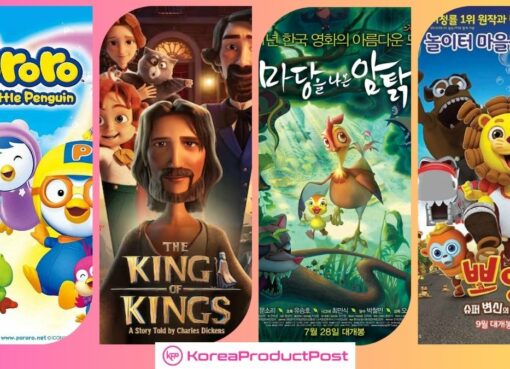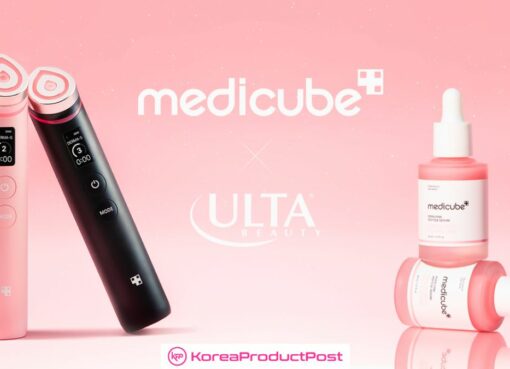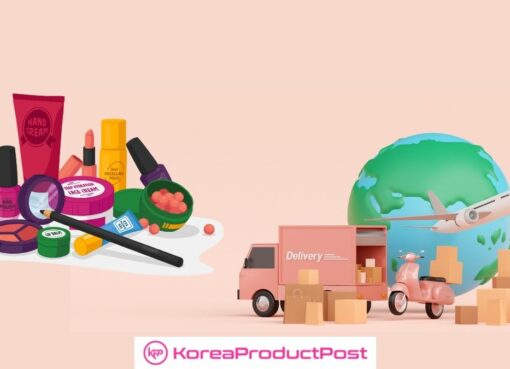From Family Mart to Loft, K-beauty is everywhere in Japan. Find out what’s fueling K-beauty’s explosive growth and what it means for the future of beauty.
South Korea has overtaken long-dominant France to become Japan’s #1 source of imported cosmetics. This historic shift took effect in 2022 and reflects changing consumer preferences as K-beauty products flood the Japanese market.
Korean cosmetic imports have skyrocketed, signaling K-beauty’s takeover in Japan. The country’s imports of K-beauty products jumped from just ¥13 billion in 2013 to an astounding ¥95.9 billion in 2023. It was a sevenfold increase over the decade. This exponential growth has set the stage for South Korea’s rise to the top of Japan’s cosmetics market.
Historical Rise of K-Beauty in Japan (2013–2023)
In the early 2000s, Korean cosmetics had little presence in Japan, but by the mid-2010s, a K-beauty wave was underway. Because of savvy marketing and word-of-mouth, Korean brands rapidly became popular, and imports increased. They surpassed imports from the U.S. and China just before 2020 and finally overtook France in 2022 to claim the top spot.
Traditionally, French cosmetics led Japan’s market thanks to luxury brands. Korean beauty’s rise has been different—it’s built on volume and value. The average unit price of Korean cosmetics is lower than that of French luxury products. Despite the lower prices, it’s sheer sales volume in Japan has been enormous. This indicates that Japanese consumers are buying more K-beauty because they like its affordability and variety.
Why Japanese Consumers Love K-Beauty
Affordability and Accessibility
One key appeal of K-beauty is its affordable price. Korean brands offer high-quality makeup and skincare at a fraction of the cost of Western luxury brands. It makes them more accessible to younger shoppers and budget-conscious consumers. For instance, popular K-beauty items often cost around ¥1,000–¥2,000, much cheaper than high-end European cosmetics.
Trend-Responsive Products
K-beauty companies are incredibly quick at spotting and creating trends. They can develop new colors, textures, and product types quickly. This means that Japanese consumers can access the latest beauty trends almost in real-time. South Korean beauty brands continuously refresh their portfolios to stay ahead of trends. It is a huge draw for trend-savvy Japanese shoppers.
Cultural Influence of Hallyu
The Korean Wave (Hallyu)—including K-pop music and K-drama television—has swept Japan’s youth culture and sparked interest in everything Korean, including beauty products. Fans eager to emulate the flawless looks of their favorite K-pop idols or K-drama actresses turn to Korean cosmetics for a similar style. This cultural fascination creates a halo effect. The popularity of BTS, BLACKPINK, or hit K-K-dramas leads Japanese consumers straight to K-beauty brands showcased by these celebrities.
Innovative and Effective Products
South Korean brands are known for innovation – introducing new product categories and inventive formulas that intrigue consumers.
Two examples stand out: Boosters and Sheet Masks. Boosters are nothing but a pre-skincare serum that enhances the absorption of subsequent products. Pioneered by K-beauty, these boosters add another step to the routine, but users love them because of their results. Sheet masks, on the other hand, are available in Japan also but not in single-use packing. Japanese consumers like the option of using a different mask every day without having to buy a set with 5-6 sheet masks.
Quality Meets Kawaii
Many Korean products also win over consumers with cute packaging and pleasant user experiences (scents, textures, etc.) while maintaining high quality. This combination of effectiveness and aesthetic appeal resonates strongly in Japan, where attention to detail is valued. In short, K-beauty makes skincare and makeup fun, trendy, and results-driven—a winning formula for Japanese shoppers.
K-beauty’s Success in Japanese Convenience Stores
Now, K-beauty has become mainstream in Japan’s convenience stores. Major chains like Family Mart, Lawson, and Seven-Eleven now offer these trendy Korean beauty products, turning ordinary convenience stores into hot spots for cosmetic shopping.
Family Mart – “hana by hince”
In March 2024, FamilyMart partnered with Korean cosmetics brand hince to launch an exclusive line called “hana by hince.” Aimed at Gen Z shoppers, this lineup of 23 items – including primers, blushes, lipsticks, tints, and nail polish – offers the same chic color palette and quality as hince’s main products for 25–35-year-olds. All items are miniaturized(travel-size) and affordable between ¥680 and ¥1,780, lowering the barrier for curious customers. For the K-beauty brands, hince, Japan has become its second biggest market, thanks to FamilyMart’s thousands of stores.
Lawson – “&nd by rom&nd”
Lawson, another big convenience chain, jumped on the K-beauty trend first. In March 2023, it launched “&nd by rom&nd,” a collaboration with popular Korean makeup brand rom&nd. The response was immediate and overwhelming: 300,000 units (initial stock expected to last two months) sold out in just three days. The &nd line has since expanded to about 30 different products and racked up a cumulative 5.4 million units sold across Japan – a testament to its ongoing popularity. Lawson and rom&nd designed &nd products to be about one-third smaller than standard. For these smaller products, the prices fall around ¥1,000, versus ¥1,500–¥3,000 for regular-size rom&nd items. This “mini” approach makes it easy for shoppers to try out products and use them, and the petite, pastel packaging creates a “cute worldview” that appeals strongly to teens and young women.
Seven-Eleven – “twinkle pop by CLIO”
Not to be outdone, Seven-Eleven Japan rolled out its own exclusive K-beauty line in May 2024: “twinkle pop by CLIO.” This collaboration with Clio is a glitter-themed makeup range targeting the MZ generation. Launched across ~20,000 Seven-Eleven stores nationwide, Twinkle Pop debuted with 22 items, including sparkling eye shadow quads, glitter gel liners, and lip tints, each priced around ¥1,000. Remarkably, Twinkle Pop is the first new makeup brand to be introduced in 7-Eleven’s beauty aisle in two decades, highlighting how significant this K-beauty foray is for the chain. The success of Twinkle Pop not only doubled Clio’s offline retail presence in Japan but also demonstrates how bringing K-beauty into convenience stores has tapped into a new audience eager for trendier, Korean-inspired makeup in quick-grab retail settings.
Japanese Consumer Trends Driving the K-Beauty Boom
Youth Enthusiasm and Wider Adoption
Young Japanese consumers (especially Gen Z and millennials) are the engine of the K-beauty craze. They are ardent followers of K-beauty trends on social media and idolize K-pop and K-drama stars. K-beauty products that promise those glossy, modern looks are hugely appealing. Convenience store data illustrates a surge in youth preferences: 51% of buyers of a new K-beauty foundation at Lawson are in their teens or 20s. This number is double what it was before the introduction of K-beauty. However, K-beauty’s appeal isn’t limited to young shoppers. Retailers note that more women in their 30s and 40s are also trying out Korean brands.
From Impulse Buys to Purposeful Shopping
Another noticeable shift is how Japanese consumers are buying cosmetics. Previously, makeup purchases at convenience stores were often spur-of-the-moment—grabbing a mascara because you forgot yours at home, for example. The introduction of K-beauty has changed this. Many customers now make intentional trips to convenience stores to pick up Korean makeup products. This kind of shopping behavior is more seen in specialty or department stores than in convenience stores. This purposeful purchasing trend showcases the strong demand and loyalty towards K-beauty brands.
Informed and Trend-Savvy Consumers
Japanese beauty consumers are highly informed; they read reviews and follow influencers for tips. K-beauty has benefited from this, as positive reviews and viral trends spread quickly online. Continuous innovation and the launch of buzz-worthy products by Korean brands give consumers different products to try. This creates a never-ending cycle: the more Japanese customers experiment with K-beauty and love the results, the more they talk about it, fueling further interest.
Industry Reactions: How Competitors Are Responding
French Brands Adapting to K-Beauty
Established French luxury cosmetics brands – once the pinnacle of prestige in Japan – are taking in the K-beauty phenomenon and are tweaking their strategies. Some are now incorporating popular K-beauty ingredients into their products. For example, new formulas may include trendy Korean skincare ingredients (think snail mucin, centella asiatica, or fermented probiotics) that Asian consumers prize. French brands may emphasize hydration and natural glow finishes inspired by Korean routines. French companies’ adoption of Korean innovations directly influences K-beauty’s effectiveness and appeal. Essentially, the French are saying: if you can’t beat them, join them – infusing a bit of Seoul into Paris to win back consumers.
Japanese Brands Embrace Korean Trends
Domestic Japanese cosmetics makers are also pivoting to align with K-beauty trends. We’re seeing Japanese brands launch products that mimic the looks and textures popularized by Korean makeup – for instance, lightweight cushion foundations for dewy skin or lip tints that give that popsicle-stained gradient look that originated in Korea. Some even collaborate with Korean influencers or adopt K-pop-style marketing to ride the wave. By tailoring their offerings to match Korea’s popular makeup styles (while still leveraging Japanese quality and tradition), local brands hope to retain customers who may otherwise be lured away entirely by K-beauty options.
Global Impact and Future Outlook of K-Beauty in Japan
The rise of Korean beauty in Japan is not happening in isolation – it’s part of a larger global shift in the beauty industry. South Korea has cemented itself as a trendsetter in cosmetics, with a level of influence now rivaling (or surpassing) the historic giants in Europe and the U.S. The fact that Japanese consumers have embraced K-beauty so wholeheartedly underscores how Korean brands and products are reshaping beauty standards worldwide. Competitors worldwide are closely watching and learning from this “K-beauty boom,” recognizing that South Korea’s dominance in beauty is a phenomenon to study and emulate.
All signs point to Korean beauty maintaining its momentum in Japan in the coming years. With continuous innovation, affordable quality, and cultural capital, K-beauty is positioned to remain at the forefront of Japan’s cosmetics market. Japanese retailers are likely to integrate Korean brands further, and we may see even more collaborations (or even Korean-Japanese co-developed products) as the trend evolves. For consumers, this means more choices and exciting new products launching regularly. In the end, the K-beauty wave in Japan symbolizes a new era of globalized beauty – one where trends know no borders, and South Korea’s beauty industry will continue to inspire and influence on the world stage.
If you’re looking to promote your products and connect with international buyers, please don’t hesitate to contact us.
Join us on an exciting journey to explore the vibrant world of Korean lifestyle – from the latest beauty tips to the hottest tech and so much more on Facebook, Twitter, LinkedIn, and Flipboard.









